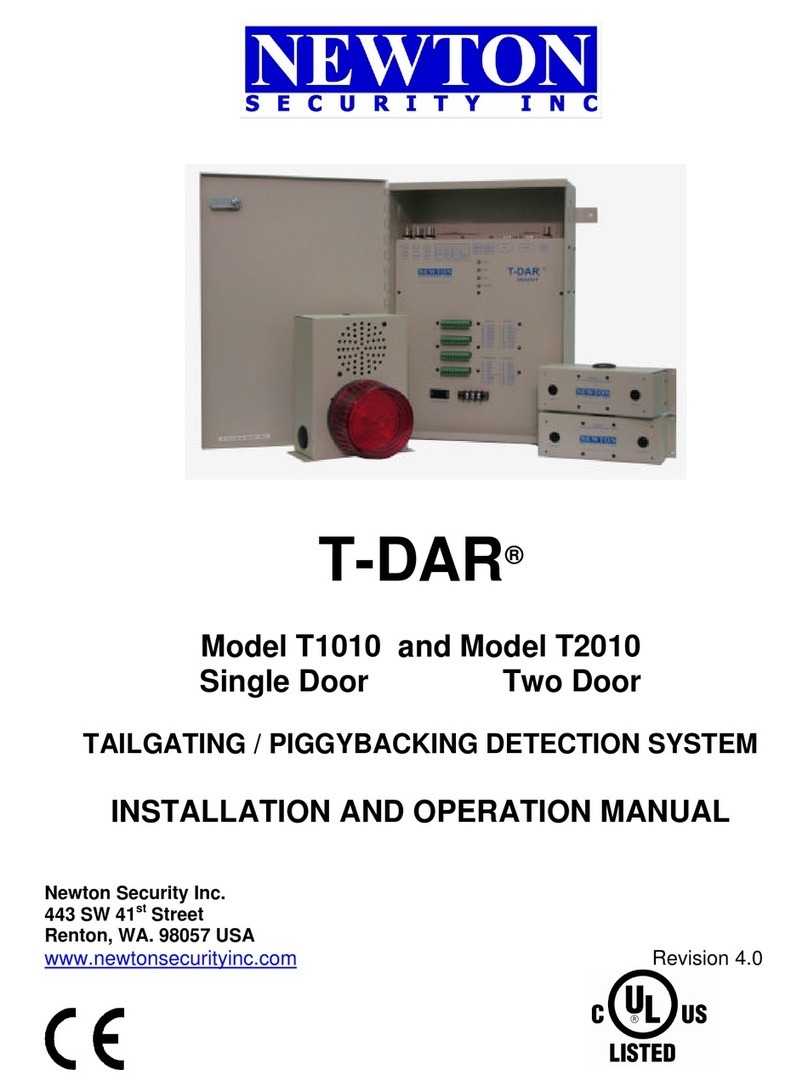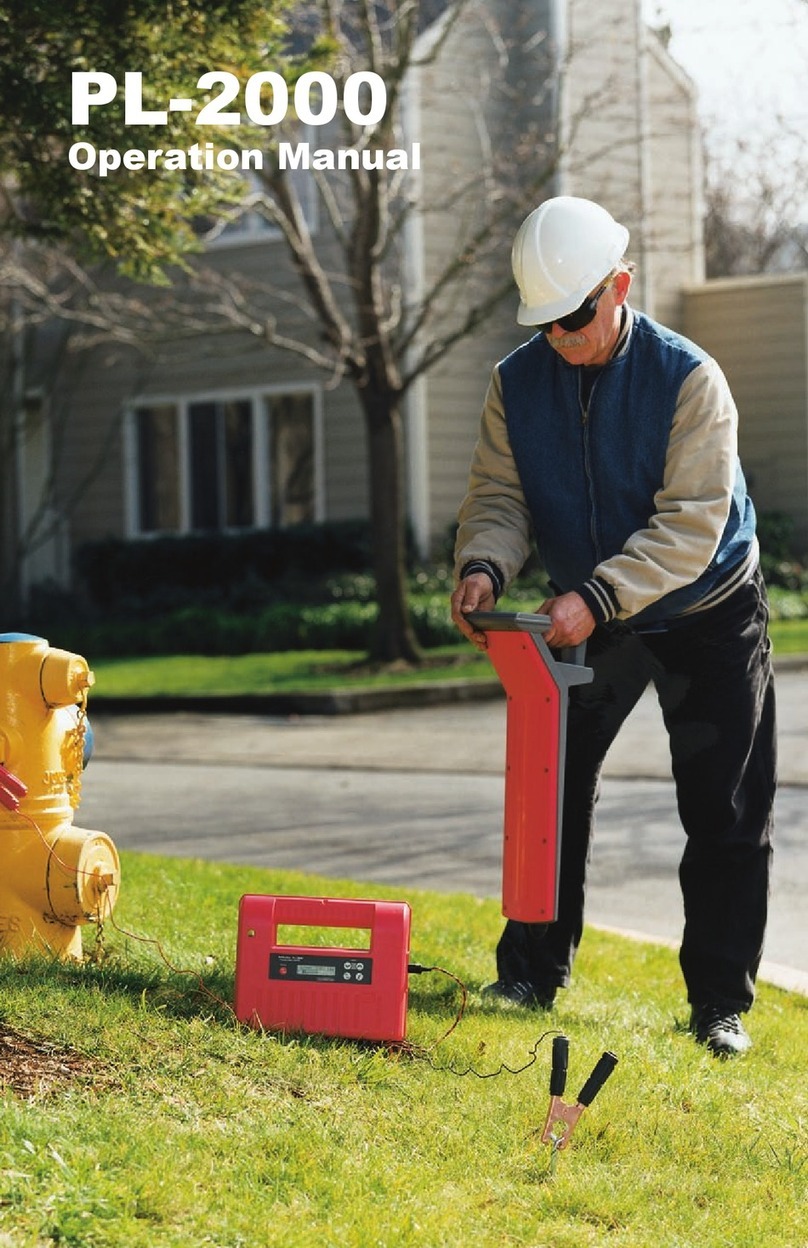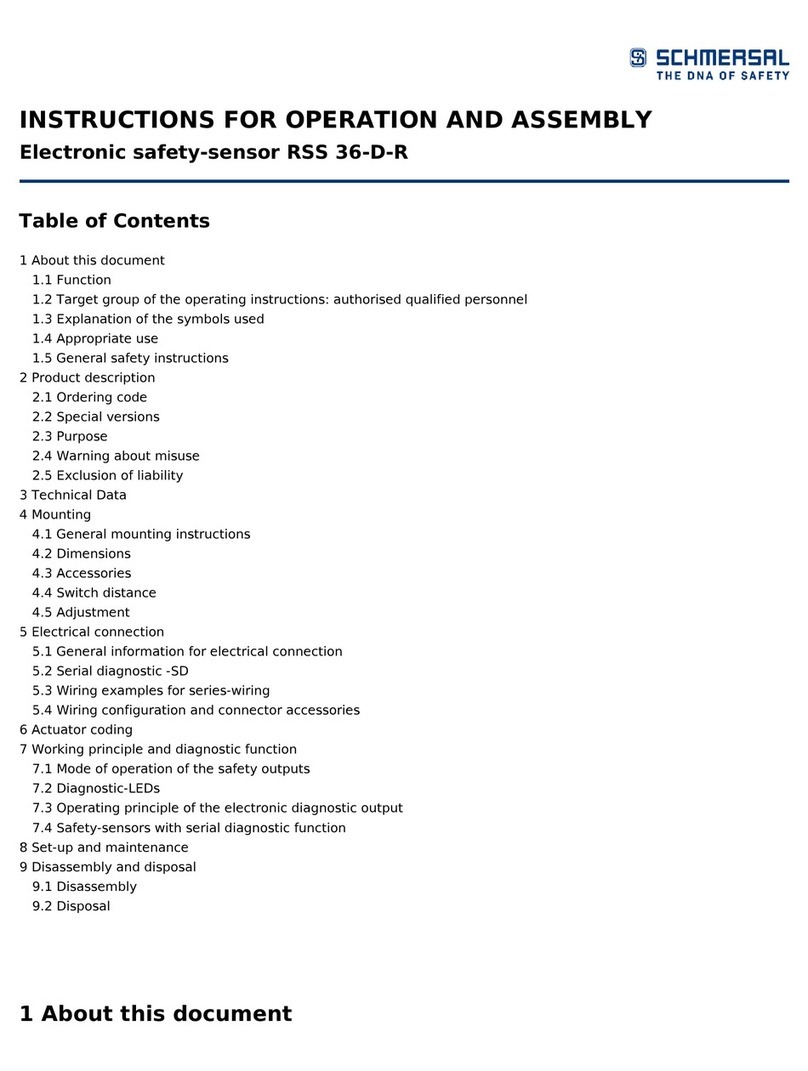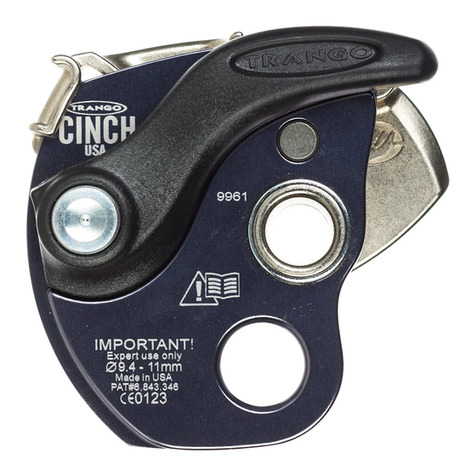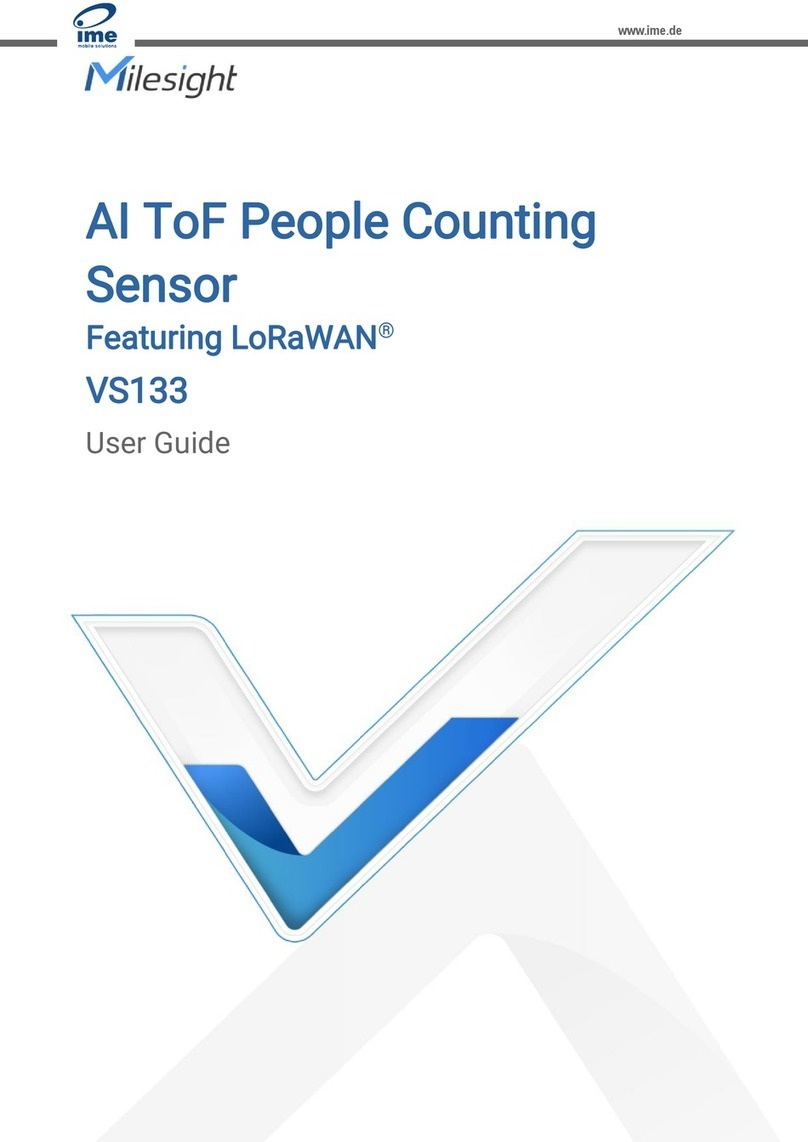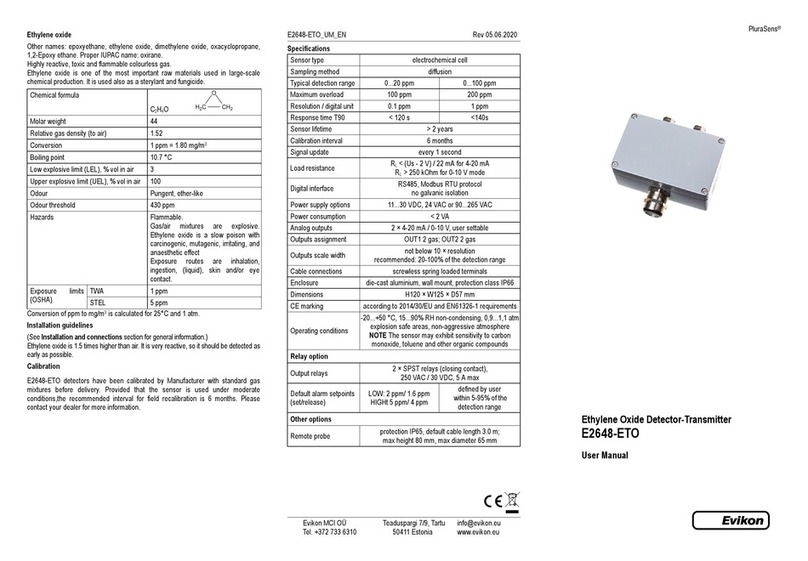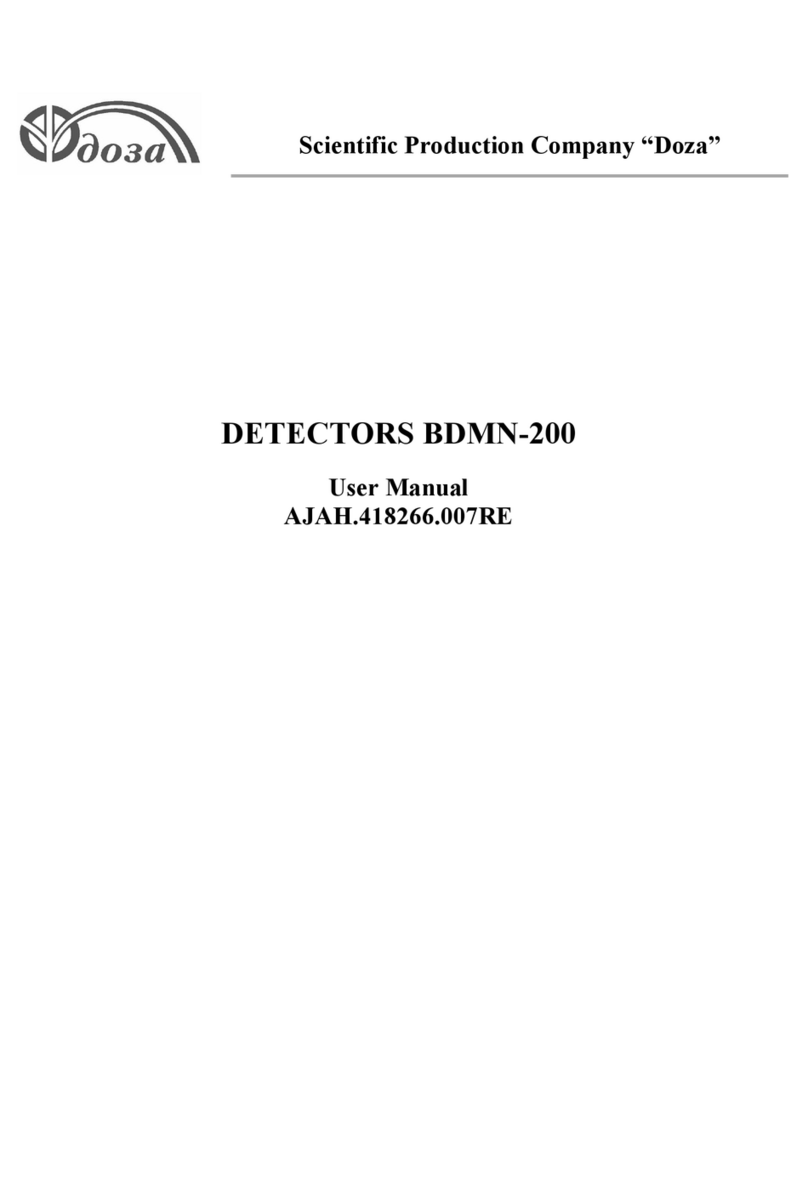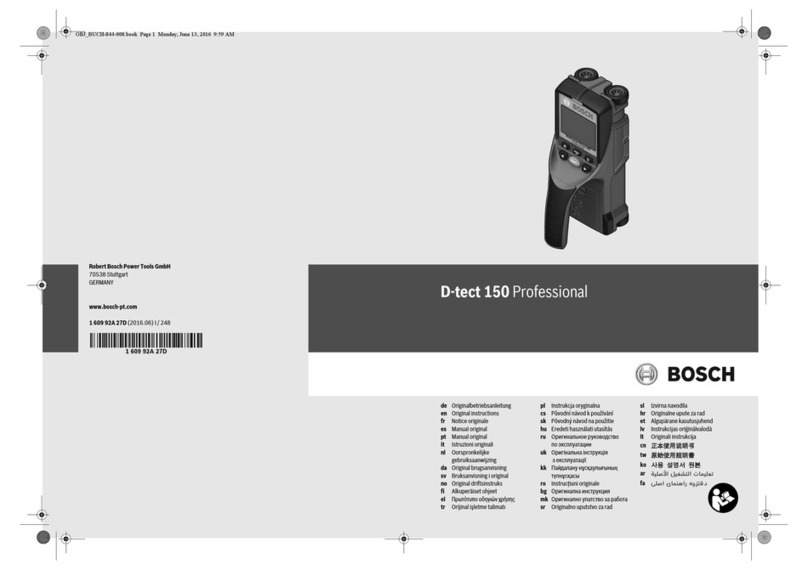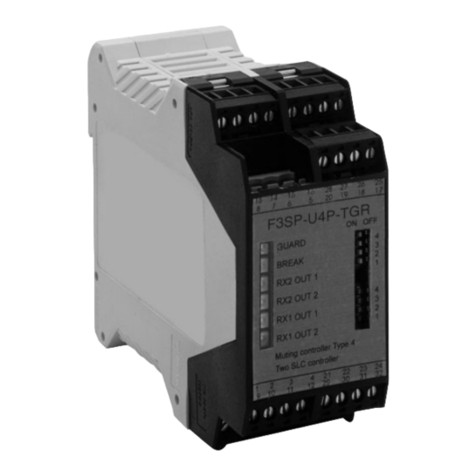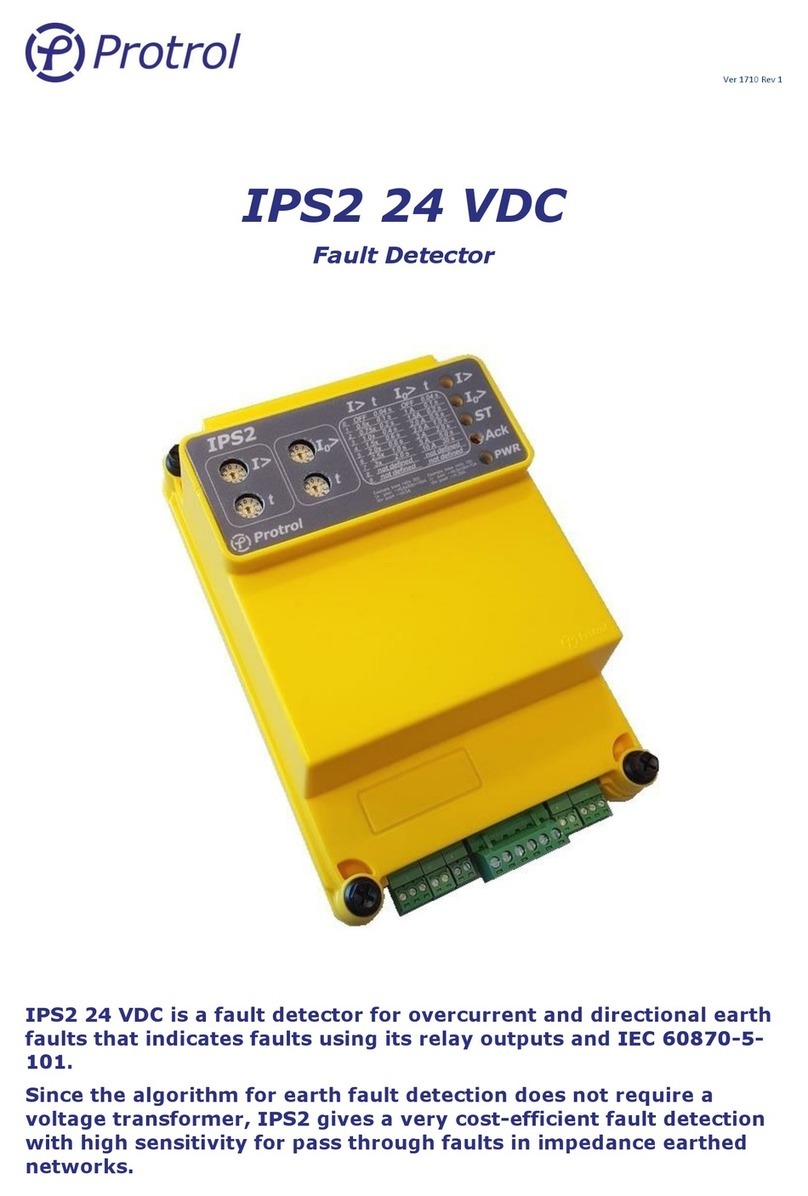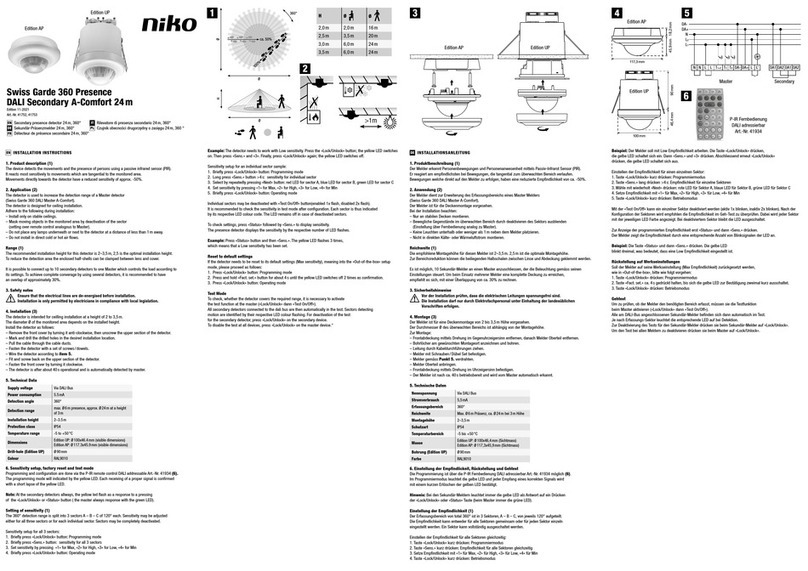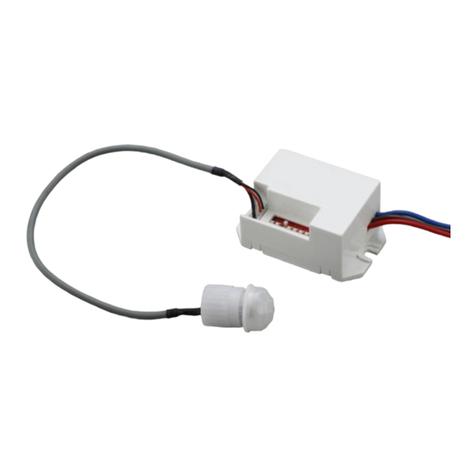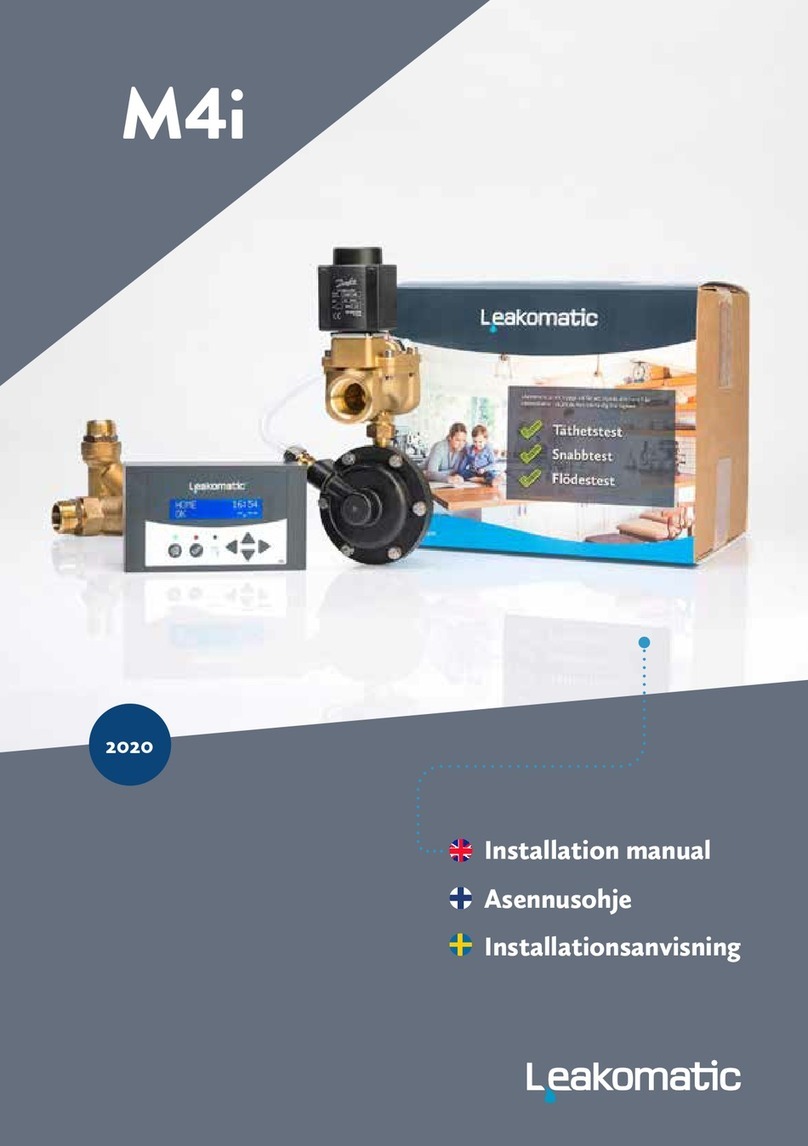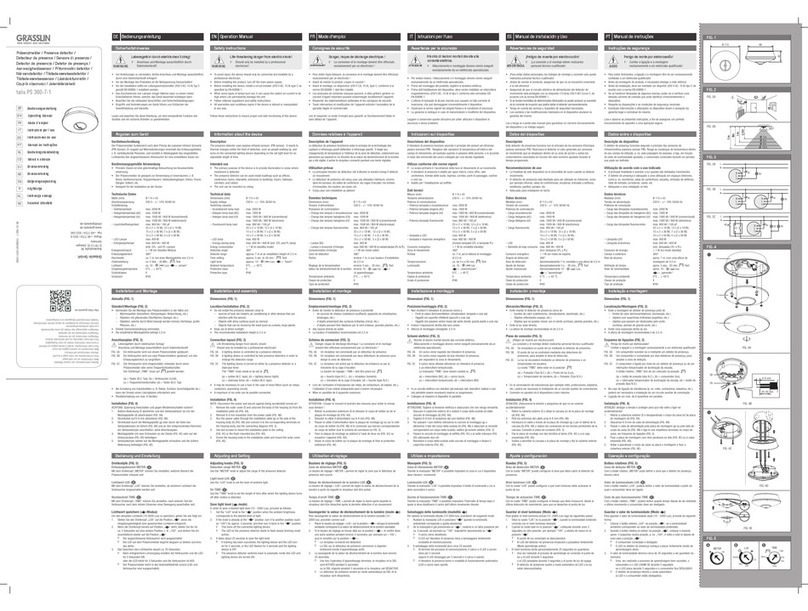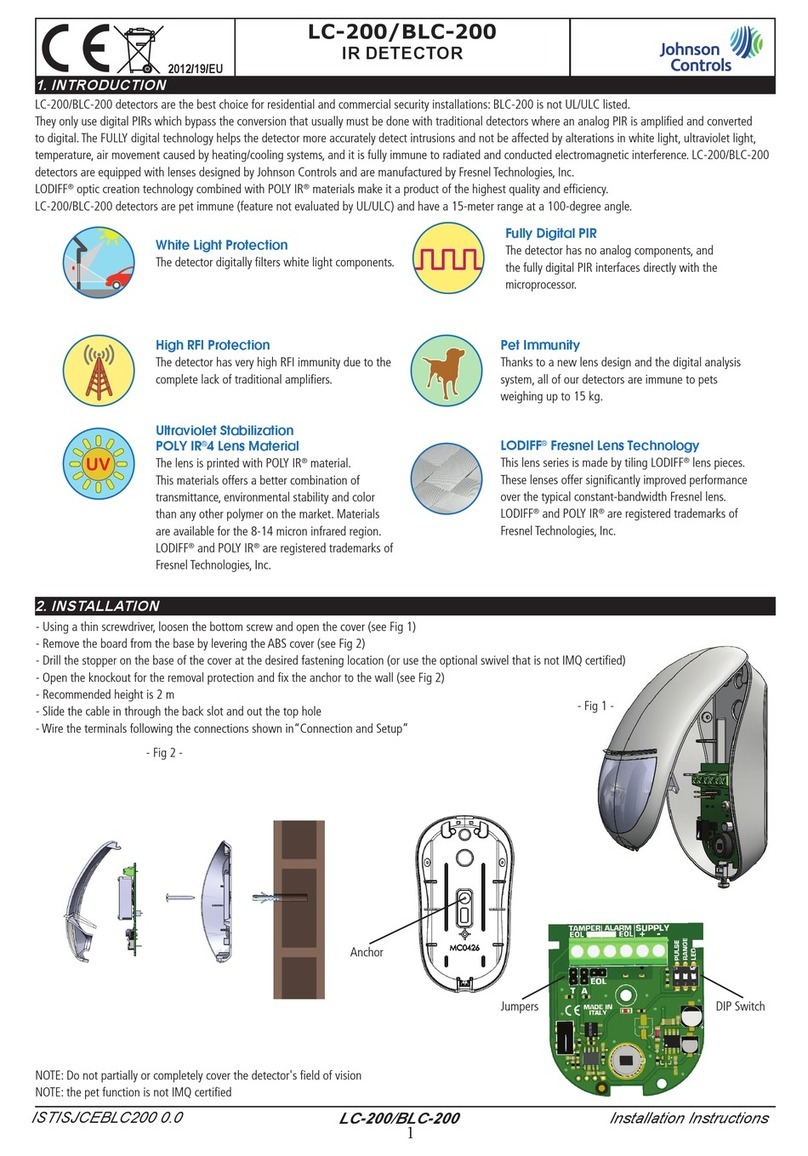Di-soric USC 30 Series User manual

Betriebsanleitung / Operating instructions
Ultraschall-Sensoren / Ultrasonic sensors
USC 30 ... B 88/3.1205de
●Ultraschall-Schranken
Bei Ultraschall-Schranken wird der Schalt-
abstand auf einen festen Reflektor (z.B.
Blech o. Ä) eingestellt. Tritt das zu erken-
nende Objekt in die Schallkeule zwischen
Ultraschall-Schranke und Reflektor ein,
reagiert der Ausgang (Schalt-/Analogaus-
gang) des Sensors. Dadurch ergibt sich für
Ultraschall-Schranken keine Blindzone vor
dem Sensor.
Ultraschall-Sensoren USC 30 ... besitzen
einen Synchronisationseingang. Damit
können mehrere, auf engem Raum unter-
gebrachte Sensoren der gleichen Type so
gesteuert werden, dass eine gegenseitige
Beeinflussung minimiert bzw. ganz unter-
drückt wird. Der Synchronisationseingang
kann auch als Freigabeeingang (Enable)
verwendet werden, über den die Sensoren
aktiv bzw. inaktiv geschaltet werden
können.
iBei Raumtemperatur können praktisch
alle Objekte innerhalb des Arbeitsberei-
ches des Sensors erfasst werden.
iEine große Oberfläche des zu erfassen-
den Objektes erhöht die Schaltsicher-
heit.
iObjekte mit glatter Oberfläche können
bis zu einem Neigungswinkel von ca.
3° sicher erkannt werden. Raue und
stark strukturierte Objekte sind mit
größeren Neigungswinkeln erfassbar.
Physikalische Anwendungsgrenzen
- Ultraschall-Sensoren sind aus physikali-
schen Gründen (Schallgeschwindigkeit
in Luft 341 m/s bei 20 °C) relativ lang-
sam.
- Aufgrund der Ultraschallfrequenz er-
rechnet sich eine Auflösung von
± 4,3 mm bei 80 kHz bzw.
± 2,8 mm bei 120 kHz bzw.
± 1,7 mm bei 200 kHz bzw.
± 0,9 mm bei 400 kHz.
- Keine Funktion unter Wasser, in Vakuum
und bei größeren Überdrücken.
- Sehr heiße (> +100 °C) oder sehr kalte
Objekte (< -10 °C) können u. U. nicht
abgetastet werden (Turbulenzen der Luft
mit Brechung und Streuung des Schalls).
- Starke Luftströmungen > 20 m/s kön-
nen die Abtastsicherheit verringern.
- Eisbildung auf der Wandleroberfläche
reduziert die Empfindlichkeit des Sen-
sors (Abhilfe durch Auftragen einer
dünnen Schicht Silikonfett auf die
Wandleroberfläche).
- Sehr kleine oder sehr schlecht reflektie-
rende (schallabsorbierende) Objekte
können u. U. nicht bis zum Grenzab-
stand erfasst werden. Schallabsorbieren-
de Materialien sind z.B. Schaumgummi,
lose Baumwolle, Filz, Textilien, ausgasen-
de Flüssigkeiten, rutschender Sand usw.
- Bei zu großer Neigung des zu erfassen-
den Objektes zur Strahlachse wird nicht
mehr genügend Schall in Empfänger-
richtung reflektiert (besonders bei
größeren, ebenen Flächen). Glatte
Objekte können bis zu einer Neigung
von 3° sicher detektiert werden. Rauhe
Oberflächen unter Umständen bis 60°
oder mehr.
Montage
!Max. Anzugsdrehmoment der Befesti-
gungsmuttern 40 Nm.
Die Montage erfolgt über das Gehäusege-
winde.
iUltraschall-Sensoren so montieren, dass
sich keine Materialien auf der Wandler-
oberfläche absetzen können.
iStarke Fremdschallquellen in der Schall-
achse von Ultraschall-Sensoren sind zu
vermeiden.
iDas Wandlergehäuse des Sensors darf
andere Maschinenteile nicht berühren.
iNie die Schallachsen von Geräten der
gleichen Baureihe aufeinander richten.
Bestimmungsgemäßer Gebrauch
Ultraschall-Sensoren USC 30 ... werden als
Bestandteil eines übergeordneten Gesamt-
systems zum Erfassen von Objekten
eingesetzt.
-Konformität
EMV-Richtlinie DIN EN 60947-5-2
Niederspannungs- 73/23/EWG
richtlinie 93/68/EWG
Sicherheitshinweise
Ultraschall-Sensoren USC 30 ... sind
nicht zulässig für Sicherheitsanwendun-
gen, insbesondere bei denen die Sicher-
heit von Personen von der Gerätefunk-
tion abhängig ist.
Ultraschall-Sensoren dürfen nicht in
explosionsgefährdeten Räumen betrie-
ben werden.
Der Betreiber des übergeordneten
Gesamtsystems, z.B. einer Maschinen-
anlage, ist für die Einhaltung der für den
speziellen Einsatzfall geltenden nationa-
len und internationalen Sicherheits- und
Unfallverhütungsvorschriften verant-
wortlich.
Bei Maschinenplanung und Verwen-
dung der Ultraschall-Sensoren sind die
einsatzspezifischen Sicherheits- und
Unfallverhütungsvorschriften einzuhal-
ten, wie z.B.:
- EN 60204, Elektrische Ausrüstung von
Maschinen
- DIN EN ISO 12100, Sicherheit von
Maschinen - Grundbegriffe, allgemei-
ne Gestaltungsleitsätze
- DIN 57100 Teil 410, Schutz gegen
gefährliche Körperströme
Montage und elektrischer Anschluss der
Ultraschall-Sensoren USC 30 ... darf nur
von Fachpersonal nach geltenden
Vorschriften in spannungsfreiem
Zustand und bei ausgeschalteter
Maschine erfolgen.
Die Maschine muss gegen Wieder-
einschalten gesichert sein.
Funktion
Ultraschall-Sensoren USC 30 ... senden
mittels eines Ultraschallwandlers Schall-
wellen einer bestimmten Frequenz über
das Übertragungsmedium Luft aus. Das
Senden der Schallwellen erfolgt in zeitlich
begrenzten Takten. Derselbe Ultraschall-
wandler dient in den Sendepausen als
Schallempfänger mit ausgeprägter Richt-
charakteristik. Das Abtastfeld ist keulen-
förmig und relativ schmal. Durch eine
Laufzeitmessung werden die in den
Sendepausen vom Zielobjekt reflektierten
Schallwellen als Echos im Gerät verarbeitet
und daraus ein abstandsproportionales
Ausgangssignal gebildet. Bei Modellen mit
Analogausgang steht dieses Signal je nach
Typ als Strom- oder Spannungswert zur
Verfügung.
Ultraschall-Sensoren USC 30 ... arbeiten
unprogrammiert als Ultraschall-Taster. Der
Anfangs- und der Endwert des Schaltbe-
reichs wird über je ein Potentiometer
eingestellt.
Sensoren mit Analogausgang liefern
unprogrammiert ein abstandsproportiona-
les Ausgangssignal von 0 ... 10 V oder
4 ... 20 mA.
●Ultraschall-Taster
Bei Ultraschall-Tastern wirkt das zu erken-
nende Objekt als Reflektor. Sobald sich ein
Objekt innerhalb des Schaltbereichs
befindet, reagiert der Ausgang (Schalt-/
Analogausgang) des Sensors.
●Ultrasonic barriers
With ultrasonic barriers the switching
distance to a fixed reflector (e.g. sheet or
metal or similar) is adjusted. The output
(switching or analog output) on the
sensor switches if the object to be de-
tected interrupts the sound lobe between
the ultrasonic barrier and the reflector.
There is therefore no blind zone in front of
the sensor on ultrasonic barriers.
Ultrasonic sensors USC 30 ... have a
synchronisation input. In this way several
sensors of the same type installed in a
small space can be controlled so that
mutual interference is minimised or sup-
pressed entirely. The synchronisation input
can also be used as an enable input to
switch the sensors active or inactive.
iAt room temperature, virtually all
objects within the sensor’s working
range can be detected.
iA large surface of the object to be
detected increases the switching reliabi-
lity.
iObjects with smooth surfaces can be
detected up to an inclination angle of
approx. 3°. Rough and heavily textured
objects can be detected at larger
inclination angles.
Physical application limits
- For physical reasons (speed of sound in
air 341 m/s at 20 °C), ultrasonic sensors
are relatively slow.
- The calculated resolution is
± 4,3 mm at 80 kHz bzw.
± 2,8 mm at 120 kHz bzw.
± 1,7 mm at 200 kHz bzw.
± 0,9 mm at 400 kHz
on the basis of the ultrasonic frequency.
- The sensors do not function under water,
in a vacuum or at high excess pressures.
- Very hot objects (> +100 °C) or very
cold objects (< -10 °C) may, under
certain circumstances, not be detected
(air turbulence with refraction and
scattering of the sound).
- Strong air flow > 20 m/s may reduce the
detection reliability.
- Ice formation on the transducer surface
reduces the sensitivity of the sensor (this
can be remedied by applying a thin coat
of silicone grease to the transducer
surface).
- Very small objects or very poorly reflec-
ting objects (sound-absorbing objects)
may, under certain circumstances, not
be detected as far as the limit zone.
Sound-absorbing materials include foam
rubber, loose cotton, felt, textiles,
outgassing fluids and slippery sand etc.
- If the object to be detected is too greatly
inclined with respect to the beam axis,
this means that adequate sound will not
be reflected in the direction of the recei-
ver (particularly in the case of large, flat
surfaces). Smooth objects may be de-
tected reliably up to an angle of inclinati-
on of 3°. Rough surfaces may be de-
tected under certain circumstances up to
an angle of inclination of 60° or more.
Assembly
!Max. tightening torque of the fastening
nuts 40 Nm.
The unit can be mounted using the hou-
sing thread.
iMount ultrasonic sensors such that no
particles can collect on the converter
surface.
iAvoid strong external sound sources on
the sound axis of ultrasonic sensors.
iThe transducer housing of the sensor
may not contact other machine com-
ponents.
iNever aim the sound axes of devices of
the same series towards each other.
Authorized use
Ultrasonic sensors USC 30 ... are used as a
part of a higher-level overall system for
detection of objects.
conformity
EMV directive DIN EN 60947-5-2
Low voltage 73/23/EWG
directive 93/68/EWG
Safety instructions
Ultrasonic sensors USC 30 ... are not to
be used for safety applications, in
particular applications in which safety of
persons depends on proper operation of
the instruments.
Ultrasonic sensors may not be operated
in explosion-hazard areas.
The operator of the higher-level overall
system, e.g. a machine installation, is
responsible for complying with the
national and international safety and
accident prevention regulations which
apply to the specific use.
When carrying out machine planning
and using the Ultrasonic sensors, the
safety and accident prevention regulati-
ons specific to use must be complied
with, e.g.:
- EN 60204, Electrical equipment of
machines
- DIN EN ISO 12100, Safety of machinery
- Basic concepts, general principles for
design
- DIN 57100 Teil 410, Protection against
dangerous electric shock
Assembly and electrical connection of
Ultrasonic sensors USC 30 ... may only
be carried out by skilled personnel
according to applicable regulations in
de-energized condition and when the
machine is switched off.
The machine must be secured to
ensure that it cannot be switched
back on.
Function
Ultrasonic sensors USC 30 ... emit sound
waves at a specific frequency through the
transmission medium of air by means of
an ultrasonic transducer. The sound waves
are emitted in time-limited cycles. The
same ultrasonic transducer is used as a
sound receiver with a distinctive directio-
nal characteristic during the transmit
pauses. The detection area is lobar and
relatively narrow. The sound waves re-
flected in the transmit pauses from the
target are processed as echoes in the unit
on the basis of a transit-time measure-
ment, and an output signal proportional
to the distance is generated from this.
On models with an analog output, this
signal is available as a current or voltage
depending on the type.
Un-programmed USC 30 ... ultrasonic
sensors operate as ultrasonic sensors. The
start and end values for the switching
range are each adjusted using a potentio-
meter.
Un-programmed sensors with an analog
output provide an output that is proporti-
onal to the distance from 0 ... 10 V or
4 ... 20 mA.
●Ultrasonic Sensors
With ultrasonic sensors the object to be
detected acts as the reflector. The output
(switching or analog output) on the
sensor switches as soon as there is an
object in the switching range.

2
iBeim Einbau in Rohre oder Behälter
muss um die Schallachse ein Freiraum
eingehalten werden. Das Verhalten des
Ultraschall-Sensors muss durch Versu-
che ermittelt werden.
Synchronisation
Wenn mehrere Sensoren in unmittelbarer
Nähe betrieben werden, kann es zu
gegenseitiger Beeinflussung kommen.
Eine sichere Abtastung ist dann nicht
mehr möglich. Durch Synchronisation des
Sendetaktes aller beteiligten Sensoren
(max. 10 Sensoren der gleichen Type)
kann erreicht werden, dass die erforderli-
chen minimalen Montageabstände ver-
kleinert und eine Beeinflussung weitge-
hend vermieden wird.
Zur Synchronisation müssen alle Synchro-
nisationseingänge der beteilign Sensoren
mit einem möglichst kurzen, abgeschirm-
ten Kabel verbunden werden.
iIm Einzelbetrieb ohne Freigabefunktion
muss der Synchronisationseingang mit
+UBverbunden werden.
Sensor 1 Sensor 2 Sensor 10
+24 V DC
0 V
Sync Sync Sync
Verdrahtung
Synchronisationseingang
Wiring
synchronisation input
Freiraum/Free space
X
Freiraum/Free space
X
USC 30 M 300 ...: X = 60 mm
USC 30 M 1300 ...: X = 300 mm
USC 30 M 3000 ...: X = 600 mm
USC 30 M 6000 ...: X = 800 mm
Elektrischer Anschluss
!Der elektrische Anschluss muss EMV-
gerecht ausgeführt werden.
!Für die Spannungsversorgung muss ein
EMV-gerechtes Netzteil verwendet
werden.
!Der Minuspol der Stromversorgung und
der Maschinenkörper müssen geerdet
werden.
!Anschlusskabel und Stromversorgungs-
leitungen nicht in unmittelbarer Nähe
von Leitungen höherer Spannungen
oder mit Leitungen, die induktive oder
kapazitive Lasten schalten, verlegen.
!Die max. Länge der Anschlussleitungen
darf 300 m nicht überschreiten. Der
Leitungsquerschnitt muss entsprechend
ausgelegt sein (Spitzenstrom!).
Der elektrische Anschluss erfolgt über
4-polige Anschlusskabel mit M12-Steck-
verbinder.
Freigabe (Enable)
Im Einzelbetrieb kann der Synchronisati-
onseingang auch als Freigabeeingang
verwendet werden, um z.B. Knet- oder
Rührwerke auszublenden. Dazu wird der
Synchronisationseingang z.B. über eine
Steuerung mit 0 V der Betriebsspannung
verbunden und der Sensor inaktiv geschal-
tet. Der Erfassungsvorgang wird dadurch
unterbrochen, ohne die Betriebsspannung
auszuschalten. Der letzte Ausgangszu-
stand bleibt erhalten. Wird der Sensor
wieder aktiv geschaltet, wird der Aus-
gangszustand aktualisiert.
Eingangssignal Funktion
+UBSensor aktiv
IE max. = 16 mA
0 V (< 3 V) Sensor inaktiv
IE max. = -11 mA
iIm Einzelbetrieb ohne Freigabefunktion
muss der Synchronisationseingang mit
+UBverbunden werden.
Manuelles Einstellen des Schaltab-
standes
Ultraschall-Sensoren USC 30 ... mit Schalt-
ausgang arbeiten unprogrammiert als
Ultraschall-Taster. Der Schaltbereich kann
über Potentiometer innerhalb des Einstell-
bereiches eingestellt werden.
Der Schaltzustand der Ausgänge (unpro-
grammiert 1 x NO oder 2 x NO) wird
durch rote LEDs angezeigt.
●1 Schaltausgang (1 x NO)
Mit den zwei Potentiometern kann der
Anfangswert A (Sens.min.) und der End-
wert E (Sens. max.) des Schaltbereichs
eingestellt werden.
iBedingung für eine korrekte Funktion:
Anfangswert kleiner Endwert!
Verdrahtungsbeispiel Wiring example
Ultraschall-
Sensor
Ultrasonic
sensor
Netzgerät
Power Supply
SPS
PLC
+
–
Meßmasse / GND
Meas. ground / GND
Analogausgang
Analog output
Analogeingang
Analog input
Betriebsspannung
Service voltage
Anschlussschema
BN = Braun/brown
BK = Schwarz/black
BU = Blau/blue
WH = Weiß/white
Connection diagram
BN
BK
BU
1
4
3
pnp
WH 2Sync.
USC 30 M ... IPSK
BN
BU
1
3
GY 5
BK 4
pnp
WH 2Sync.
Out 1
Out 2 pnp
USC 30 M ... I2PSK
BN
BU
1
3
GY 5
BK 4
WH 2 Sync.
pnp
USC 30 M ... I0/10
USC 30 M ... I4/20
Einstellbereich / setting range
Schaltbereich / switching range
min. max.
AE
LED (NO)LED aus/off (NO)
A < E
Sens. min. Sens. max.
Blindbereich/
blind zone
LED aus/off (NO)
iOn installation in pipes or tanks, free
space must be provided around the
sound axis. The behaviour of the
ultrasonic sensor must be determined
by trial.
Electrical connection
!The electrical connection must be made
in such a manner as to ensure electro-
magnetic compatibility (EMC).
!Please us an EMC-compliant power
pack for the power supply.
!The negative terminal of the power
supply and the machine body must be
connected to ground.
!Do not lay connection lead and power
supply cables in the direct vicinity of
cables conducting high voltages or
cables which switch inductive or capa-
citive loads.
!The connection leads may not exceed a
max. length of 300 m. The cable cross-
section must be designed accordingly
(peak current!).
The unit must be connected electrically via
a 4-core connection cable with M12 plug
connector.
Synchronisation
If several sensors are operated close
together, mutual interference may occur.
Reliable detection is then no longer pos-
sible. By synchronising the transmit cycles
on all related sensors (max. 10 sensors of
the same type), you can reduce the mini-
mum mounting distances necessary and
largely prevent interference.
To use synchronisation, all synchronisation
inputs on the related sensors must be
connected using a screened cable that is
as short as possible.
iOn operation separately without the
enable function, the synchronisation
input must be connected to +UB.
Enable
On operation separately, the synchronisati-
on input can also be used as an enable
input, for e.g. blanking kneading or
stirring mechanisms. For this purpose the
synchronisation input is, e.g., connected
via a controller to the service voltage 0 V
and the sensor switched inactive. The
detection process is then interrupted
without the need to switch off the service
voltage. The last output state is retained.
When the sensor is switched active again,
the state of the output is updated.
Input signal Function
+UBSensor activ
IE max. = 16 mA
0 V (< 3 V) Sensor not activ
IE max. = -11 mA
iOn operation separately without the
enable function, the synchronisation
input must be connected to +UB.
Manually adjusting the switching
distance
Un-programmed ultrasonic sensors USC
30 ... with a switching output operate as
ultrasonic sensors. The switching range
can be adjusted within the adjustment
range using potentiometers.
The switching state of the outputs (un-
programmed 1 x NO or 2 x NO) is indica-
ted by red LEDs.
●1 switching output (1 x NO)
The start value A (Sens.min.) and the end
value E (Sens. max.) for the switching
range can be adjusted using the two
potentiometers.
iCondition for correct function: start
value less than end value!

3
- Potentiometer Sens. min. gegen den
Uhrzeigersinn auf Linksanschlag (kleinster
Anfangswert) drehen
- Potentiometer Sens. max. im Uhrzeiger-
sinn auf Rechtsanschlag (größter End-
wert) drehen
- Objekt am gewünschten Anfang des
Schaltbereichs im Abtastfeld plazieren.
iDer Minimalabstand muss größer als
der Blindbereich sein (siehe Abtastfel-
der).
- Potentiometer Sens. min. langsam im
Uhrzeigersinn drehen, bis der Ausgang
schaltet.
Die LED leuchtet und der Anfang des
Schaltbereichs ist eingestellt.
- Jetzt das Objekt am gewünschten Ende
des Schaltbereichs im Abtastfeld plazie-
ren.
- Potentiometer Sens. max. langsam
gegen den Uhrzeigersinn drehen, bis der
Ausgang abschaltet.
Die LED erlischt und das Ende des Schalt-
bereichs ist eingestellt.
●2 Schaltausgänge (2 x NO)
Mit den zwei Potentiometern können die
Schaltpunkte A (Sens.min.) und E (Sens.
max.) eingestellt werden.
Über diese Schaltpunkte definieren sich
die Schaltbereiche der Ausgänge entspre-
chend der folgenden Grafik (NO).
iBedingung für eine korrekte Funktion:
Schaltpunkt A kleiner Schaltpunkt E.
- Potentiometer Sens. min. gegen den
Uhrzeigersinn auf Linksanschlag drehen
- Potentiometer Sens. max. im Uhrzeiger-
sinn auf Rechtsanschlag drehen
- Objekt am gewünschten Punkt A im
Abtastfeld plazieren.
iDer Minimalabstand muss größer als
der Blindbereich sein (siehe Abtastfel-
der).
- Potentiometer Sens. min. langsam im
Uhrzeigersinn drehen, bis der Ausgang
OUT 2 schaltet.
Die LED 2 leuchtet und der Schaltbereich
2 ist eingestellt.
- Jetzt das Objekt am gewünschten Punkt
E im Abtastfeld plazieren. Der Ausgang
OUT 1 schaltet und die LED 1 leuchtet.
- Potentiometer Sens. max. langsam
gegen den Uhrzeigersinn drehen, bis der
Ausgang OUT 1 abschaltet.
Die LED 2 erlischt und das Ende des
Schaltbereichs ist eingestellt.
Programmierung mit PC-Sensorinter-
face
Die Ultraschall-Sensoren USC 30 ... wer-
den über das PC-Sensorinterface an die
RS232-Schnittstelle eines PCs angeschlos-
sen und können über die mitgelieferte
Software programmiert werden.
Je nach Sensor können verschiedene
Parameter eingestellt werden (siehe
Tabelle Seite 4).
Alle Parameter können abgespeichert,
ausgedruckt und somit für die Anlagen-
dokumentation verwendet werden.
Abgespeicherte Parameter können für
Ersatzsensoren oder für eine Serienpro-
grammierung auf den Sensor übertragen
werden.
Wartung und Reparatur
!Keine lösungsmittelhaltigen Reiniger
verwenden.
!Ultraschall-Sensoren nicht mit heißem
Dampf reinigen.
Ultraschall-Sensoren USC 30 ... sind
weitestgehend wartungsfrei.
Ablagerungen auf der Schallwandlerober-
fläche regelmäßig mit einem weichen
Tuch entfernen.
Reparatur nur durch di-soric.
Gewährleistung
Es gelten die gesetzlichen Gewährleistungs-
bestimmungen.
USC 30 M 6000 ...
Maßzeichnung / Dimensional drawing
mm (typ.)
USC 30 M 300 ... / USC 30 M 1300 ...
mm (typ.)
max. 40 Nm
USC 30 M 3000 ...
mm (typ.)
M30x1,5
∅27,5
M12x1
10,5
80
131
36
5
14
∅26
Sens. max.
Sens.
min.
LED 1 (OUT 1)
LED 2 (OUT 2)*
M30x1,5
∅47,5
M12x1
10,5
33
19
99
150
36
5
14
∅34
∅27,5
∅26
Sens. max.
Sens.
min.
LED 1 (OUT 1)
LED 2 (OUT 2)*
M30x1,5
∅27,5
M12x1
10,5
36
22
102
153
36
5
14
∅65
∅34
∅26
Sens. max.
Sens.
min.
LED 1 (OUT 1)
LED 2 (OUT 2)*
max. 40 Nm
max. 40 Nm
* nur /only
USC 30 M ... I2PSK-BSL
* nur /only
USC 30 M ... I2PSK-BSL
* nur /only
USC 30 M ... I2PSK-BSL
Einstellbereich / setting range
min. max.
AE
aus/offOUT 1 / LED 1 (NO)
OUT 2 / LED 2 (NO)
A < E
Sens. min. Sens. max.
Blindbereich/
blind zone
Schaltbereich 2 /
switching range 2
Schaltbereich 1 /
switching range 1
aus/off
aus/off
aus/off
- Turn Sens. min. potentiometer counter-
clockwise to the left stop (smallest start
value)
- Turn Sens. max. potentiometer clockwi-
se to the right stop (largest end value)
- Place object at the required start of the
switching range in the detection area.
iThe minimum distance must be greater
than the blind zone (see detection
areas).
- Slowly turn Sens. min. potentiometer
clockwise until the output switches.
The LED illuminates and the start of the
switching range is set.
- Now place object at the required end of
the switching range in the detection
area.
- Slowly turn Sens. max. potentiometer
counter-clockwise until the output
switches off.
The LED goes out and the end of the
switching range is set.
●2 switching outputs (2 x NO)
The switching points A (Sens.min.) and E
(Sens. max.) can be adjusted using the
two potentiometers.
Using these switching points you can
define the switching ranges for the out-
puts as per the following illustration (NO).
iCondition for correct function: switching
point A less than switching point E.
- urn Sens. min. potentiometer counter-
clockwise to the left stop
- Turn Sens. max. potentiometer clockwi-
se to the right stop
- Place object at required point A in the
detection area.
iThe minimum distance must be greater
than the blind zone (see detection
areas).
- Slowly turn Sens. min. potentiometer
clockwise until the output OUT 2 swit-
ches.
LED 2 illuminates and switching range 2 is
saved.
- Now place the object at required point E
in the detection area. The output OUT 1
switches and LED 1 illuminates.
- Slowly turn Sens. max. potentiometer
counter-clockwise until output OUT 1
switches off.
LED 2 goes out and the end of the swit-
ching range is set.
Programming using PC-sensor inter-
face
The ultrasonic sensors USC 30 ... are
connected via the PC-sensor interface to
the RS232 interface on a PC and can be
programmed using the software supplied.
Various parameters can be set depending
on the sensor (see table page 4).
All parameters can be saved, printed out
and therefore used for the system docu-
mentation.
Saved parameters can be transferred to
the sensor for sensor replacement or for
programming a series of sensors.
Maintenance and repair
!Please do not use cleaning agents
containing solvents.
!Do not clean ultrasonic sensors with
hot steam.
Ultrasonic sensors USC 30 ... are largely
maintenance-free.
Regularly remove deposits on the surface
of the sound transducer using a soft cloth.
Repair by di-soric only.
Warranty
The legal warranty regulations apply.

4
Abtastfelder / Detection areas
Darstellung: optimale Reflexion, Dämpfung 0 / Depiction: optimal reflection, damping 0
USC 30 M 300 ...
mm (typ.)
Blindbereich
Blind zone
-120
-105
-90
-75
-60
-45
-30
-15
0
15
30
45
60
75
90
105
120
100500 150 200 250 300 350 400 450 500 550 600 650 700
max.
typ.
min.
Sensortyp / Sensor model
Programmierbare Programmable USC 30 M 300 IPSK-BSL USC 30 M 300 I2PSK-BSL USC 30 M 300 I4/20PSK-BSL USC 30 M 1300 I0/10PSK-BSL
Parameter parameters USC 30 M 1300 IPSK-BSL USC 30 M 1300 I2PSK-BSL USC 30 M 1300 I4/20PSK-BSL USC 30 M 300 I0/10PSK-BSL
USC 30 M 3000 IPSK-BSL USC 30 M 3000 I2PSK-BSL USC 30 M 3000 I4/20PSK-BSL USC 30 M 3000 I0/10PSK-BSL
USC 30 M 6000 IPSK-BSL USC 30 M 6000 I2PSK-BSL USC 30 M 6000 I4/20PSK-BSL USC 30 M 6000 I0/10PSK-BSL
Anfang Schaltbereich Start of switching range ●●
Ende Schaltbereich End of switching range ●●
Hysterese Hysteresis ●●
Art der Hysterese Typ of hysteresis normal oder erweitert / normal or extended –
Ausgangsfunktion Output function Schließer oder Öffner / NO or NC Schließer oder Öffner / NO or NC
Sensor-Funktion Sensor function Reflexions-Taster oder
Reflexions-Schranke / ––
ultrasonic sensor or
ultrasonic barrier
Einstellung Adjustment mit Potentiometer oder programmierbar / Potentiometer für Schaltausgang oder Analogausgang /
via potentiometer or programmable potentiometer for switching output or analog output
Analoger Anfangswert Starting value analog –●
Analoger Endwert End value analog –●
Kennlinie Characteristics –steigend oder fallend / rising or decreasing
Analogausgang Analog output –0 ... 20 mA / 4 ... 20 mA 0 ... 10 V
Blindzone Blind zone ●
Erfassungsbereich Recognition area ●
Mittelwert 1) Average value 1) ●
Dämpfung 2) Attenuation 2) ●
Temperaturkompensation Temp. compensation EIN oder AUS / ON or OFF
Schaltfrequenz Switching frequency normal / schnell –
Reaktionsgeschwindigkeit Reaction rate –normal / schnell
Ausgangszustand Output state gespeichert oder nicht gespeichert / hold or normal
1) Mit der Mittelwertbildung kann z. B. ein Rührwerk (der Abstand zum Meßobjekt ändert sich ständig) ausgeblendet werden. Dazu wird aus 2 ... 255 Meßwerten (programmier-
bar) der Mittelwert gebildet und als Ausgangssignal ausgegeben.
By forming the average value, e.g., a stirring mechanism can be blanked (the distance to the measured object changes continuously. For this purpose the average value is
formed from 2 ... 255 measured values (programmable) and output as an output signal.
2) Um die Beeinflussung der Schallkeule durch kleine Objekte im Randbereich zu verhindern, kann ein Dämpfungswert von 1 ... 7 eingestellt werden. Der Empfänger wird dadurch
unempfindlicher und reagiert nur auf starke Signale von großen Flächen.
To prevent small objects at the edges affecting the switching lobe, an attenuation value from 1 ... 7 can be set. The receiver is then less sensitive and only reacts to strong signals
from large areas.
Programmierbare Parameter / Programmable parameters

5
USC 30 M 1300 ...
mm (typ.)
Blindbereich
Blind zone
-420
-360
-300
-240
-180
-120
-60
0
60
120
180
240
300
360
420
0 500 1000 1500 2000
max.
typ.
min.
USC 30 M 3000 ...
mm (typ.)
Blindbereich
Blind zone
-900
-750
-600
-450
-300
-150
0
150
300
450
600
750
900
0 300 600 900 1200 1500 1800 2100 2400 2700 3000
max.
typ.
min.
USC 30 M 6000 ...
mm (typ.)
Blindbereich
Blind zone
-1200
-1000
-800
-600
-400
-200
0
200
400
600
800
1000
1200
0 500 1000 1500 2000 2500 3000 3500 4000 4500 5000 5500 6000
max.
typ.
min.

di-soric
Industrie-electronic GmbH & Co.
Steinbeisstraße 6
D 73660 Urbach
Telefon ++49 (0) 71 81 / 98 79 0
Telefax ++49 (0) 71 81 / 98 79 21
e-mail [email protected]
Internet www.di-soric.de
Alle technischen Angaben beziehen sich auf den
Stand 12/05, Änderungen bleiben vorbehalten.
Da Irrtümer und Druckfehler nicht auszuschließen
sind, gilt für alle Angaben „ohne Gewähr“.
All technical specifications refer to the state of
the art 12/05, they are subject to modifications.
As typographical and other errors cannot be excluded,
all data are given „without engagement“.
Technische Daten Technical data
bei 20 °C, 24 V DC at 20 °C, 24 V DC USC 30 M 300 ... USC 30 M 1300 ... USC 30 M 3000 ... USC 30 M 6000 ...
Arbeitsbereich Scanning range 60 ... 300 mm 200 ... 1300 mm 400 ... 3000 mm 600 ... 6000 mm
Einstellbereich Adjustment range 80 ... 300 mm 220 ... 1300 mm 420 ... 3000 mm 640 ... 6000 mm
Normmessplatte Standard target 10 x 10 mm 20 x 20 mm 50 x 50 mm 100 x 100 mm
Hysterese Hystersis 10 mm 10 mm 20 mm 60 mm
Wiederholgenauigkeit Repeat accuracy ± 0,45 mm ± 2 mm ± 5 mm ± 9 mm
Sendefrequenz Operating frequency 400 kHz 200 kHz 120 kHz 80 kHz
Betriebsspannung Service voltage 12 ... 30 V DC 1) 12 ... 30 V DC 1) 12 ... 30 V DC 1) 12 ... 30 V DC 1)
Eigenstromaufnahme Internal power consumption ≤50 mA ≤50 mA ≤50 mA ≤50 mA
≤60 mA (mit Analogausgang) ≤60 mA (mit Analogausgang) ≤60 mA (mit Analogausgang) ≤60 mA (mit Analogausgang)
Schaltausgang Switching output Transistor pnp, 300 mA, NO Transistor pnp, 300 mA, NO Transistor pnp, 300 mA, NO Transistor pnp, 300 mA, NO
Spannungsfall Voltage drop ≤3,0 V ≤3,0 V ≤3,0 V ≤3,0 V
Schaltfrequenz Switching frequency ≤8 Hz ≤4 Hz ≤2 Hz ≤1 Hz
≤5 Hz (mit Analogausgang)
Analogausgang Analog output 0 ... 10 V, Last/load > 2 kΩ; 0 ... 10 V, Last/load > 2 kΩ; 0 ... 10 V, Last/load > 2 kΩ; 0 ... 10 V, Last/load > 2 kΩ;
(je nach Typ, (dependent on type, 4 ... 20 mA, 4 ... 20 mA, 4 ... 20 mA, 4 ... 20 mA,
siehe Typenschild) see rating plate) Last/load max. 500 ΩLast/load max. 500 ΩLast/load max. 500 ΩLast/load max. 500 Ω
Genauigkeit (Analogausgang) Accuracy (analog output) ± 1,5 % ± 1,5 % ± 1,5 % ± 1,5 %
Ansprechzeit Response time 0,08 s 0,11 s 0,2 s 0,4 s
0,1 s (mit Analogausgang) 0,12 s (mit Analogausgang)
Umgebungstemperatur Ambient temperature -25 ... +70 °C -25 ... +70 °C -25 ... +70 °C -25 ... +70 °C
Isolationsspannungsfestigkeit Insulation voltage endurance 500 V 500 V 500 V 500 V
Schutzart Protection class IP 65 IP 65 IP 65 IP 65
Gehäusematerial Casing material Messing vernickelt / Messing vernickelt / Messing vernickelt / Messing vernickelt /
nickel-plated brass nickel-plated brass nickel-plated brass nickel-plated brass
Wandleroberfläche Transducer surface Epoxidharz / epoxy resin Epoxidharz / epoxy resin Epoxidharz / epoxy resin Epoxidharz / epoxy resin
Wandlerabdeckung Transducer enclosure PBTP (Crastin) PBTP (Crastin) PBTP (Crastin) PBTP (Crastin)
1) Arbeitsbereich bei betriebsspannung 12 ... 20 V DC um ca. 20% reduziert.
Scanning range reduced about 20% at operating voltage 12 ... 20 V DC
This manual suits for next models
16
Other Di-soric Security Sensor manuals
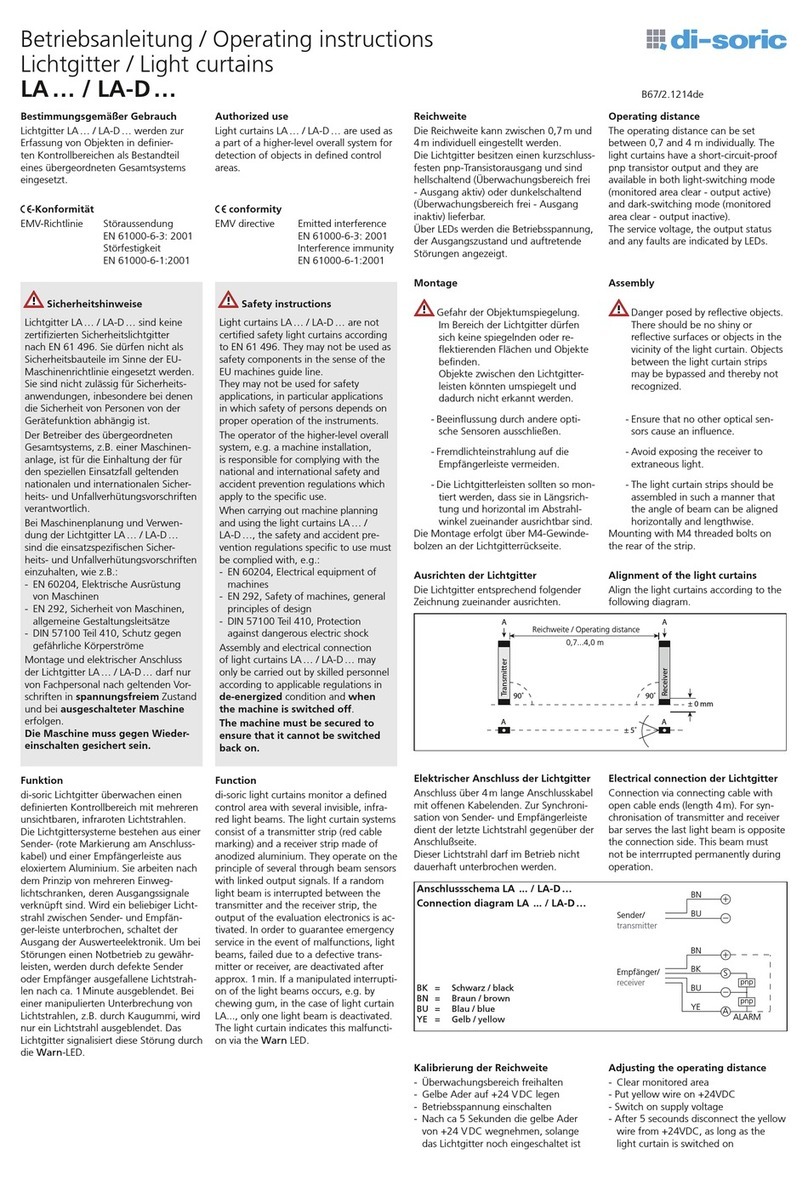
Di-soric
Di-soric LA Series User manual
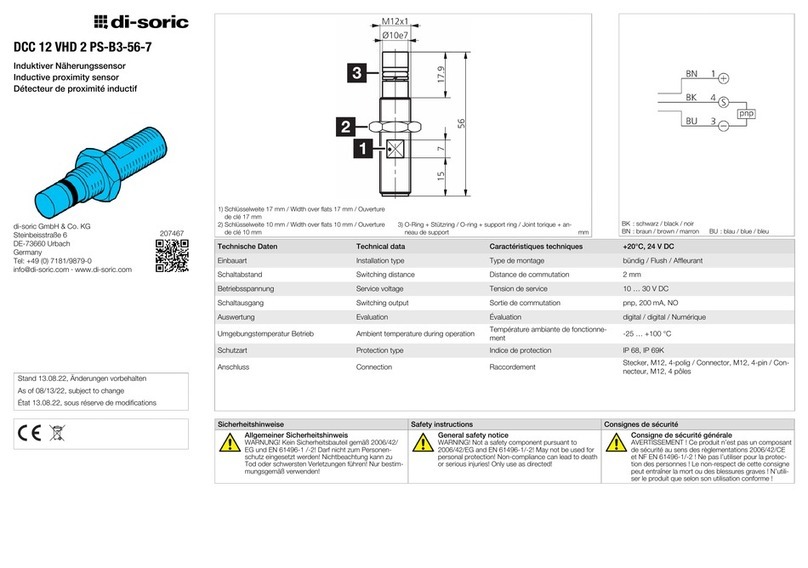
Di-soric
Di-soric DCC 12 VHD 2 PS-B3-56-7 User manual

Di-soric
Di-soric LAT52-80IU-RB5 User manual
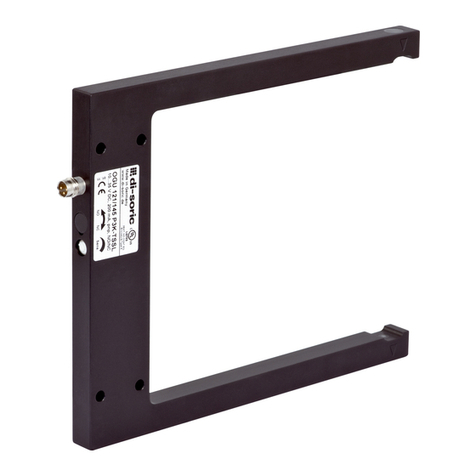
Di-soric
Di-soric OGU 021 P3K-TSSL Instruction manual

Di-soric
Di-soric OBS 105 M 30 INC-x User manual
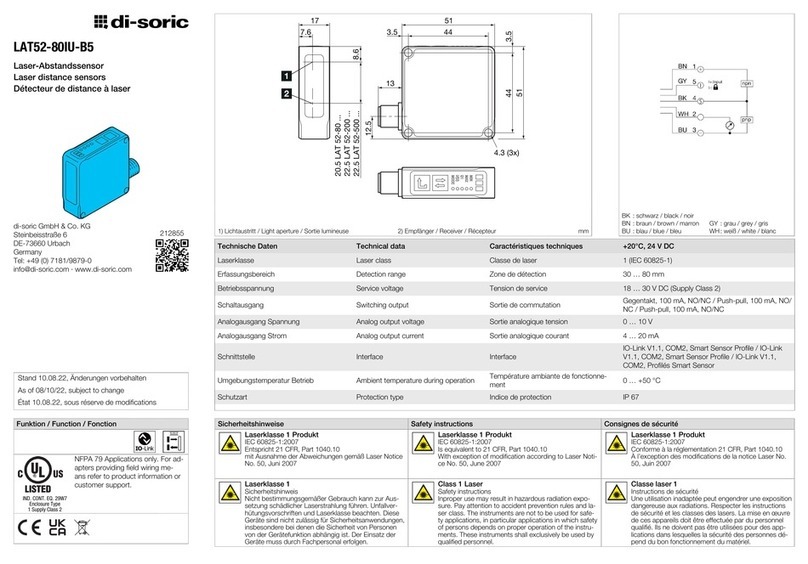
Di-soric
Di-soric LAT52-80IU-B5 User manual
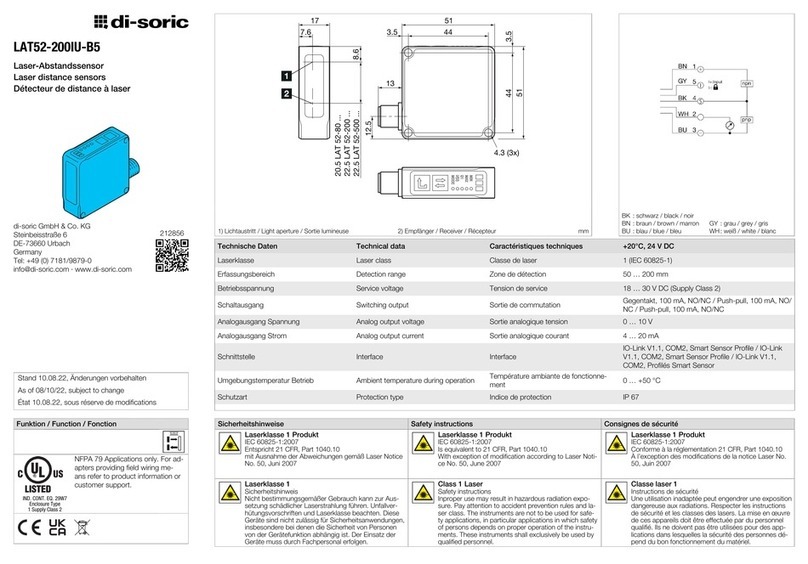
Di-soric
Di-soric LAT52-200IU-B5 User manual
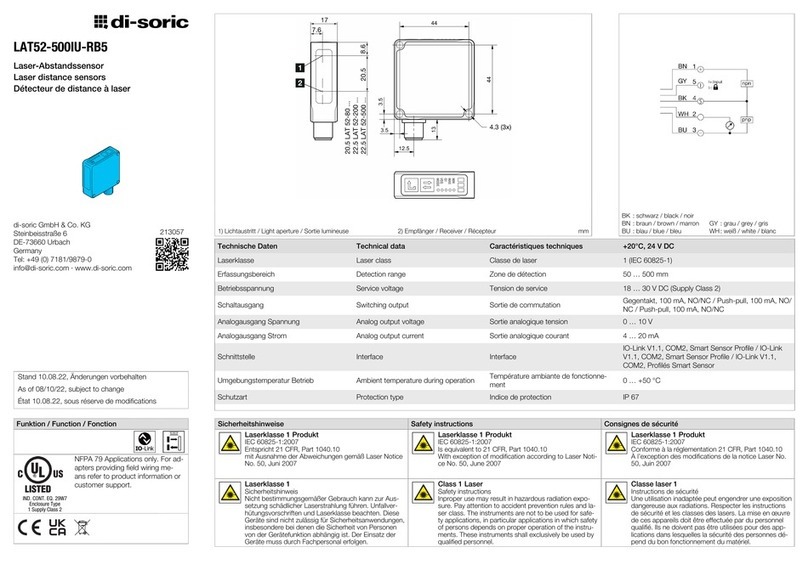
Di-soric
Di-soric LAT52-500IU-RB5 User manual
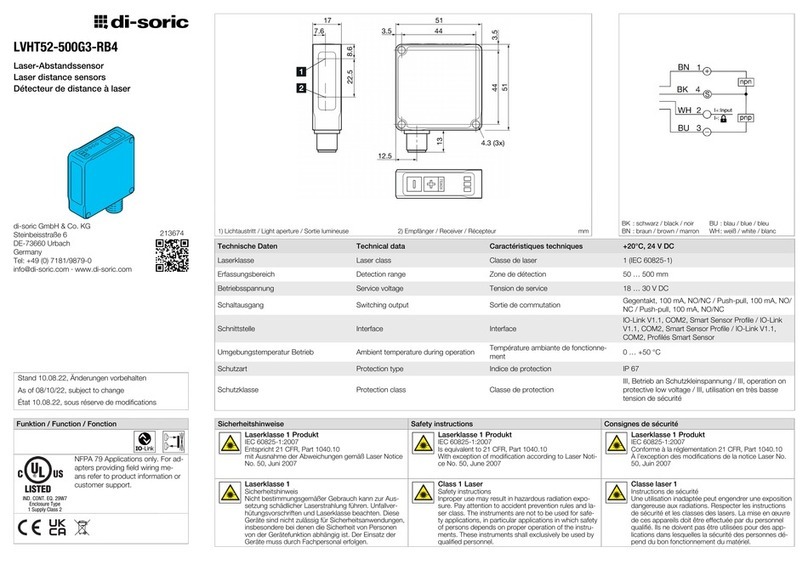
Di-soric
Di-soric LVHT52-500G3-RB4 User manual

Di-soric
Di-soric OGUL 021 G3-T3 User manual
